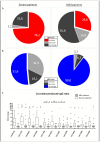Distinct antibody responses of patients with mild and severe leptospirosis determined by whole proteome microarray analysis
- PMID: 28141801
- PMCID: PMC5302828
- DOI: 10.1371/journal.pntd.0005349
Distinct antibody responses of patients with mild and severe leptospirosis determined by whole proteome microarray analysis
Abstract
Background: Leptospirosis is an important zoonotic disease worldwide. Humans usually present a mild non-specific febrile illness, but a proportion of them develop more severe outcomes, such as multi-organ failure, lung hemorrhage and death. Such complications are thought to depend on several factors, including the host immunity. Protective immunity is associated with humoral immune response, but little is known about the immune response mounted during naturally-acquired Leptospira infection.
Methods and principal findings: Here, we used protein microarray chip to profile the antibody responses of patients with severe and mild leptospirosis against the complete Leptospira interrogans serovar Copenhageni predicted ORFeome. We discovered a limited number of immunodominant antigens, with 36 antigens specific to patients, of which 11 were potential serodiagnostic antigens, identified at acute phase, and 33 were potential subunit vaccine targets, detected after recovery. Moreover, we found distinct antibody profiles in patients with different clinical outcomes: in the severe group, overall IgM responses do not change and IgG responses increase over time, while both IgM and IgG responses remain stable in the mild patient group. Analyses of individual patients' responses showed that >74% of patients in the severe group had significant IgG increases over time compared to 29% of patients in the mild group. Additionally, 90% of IgM responses did not change over time in the mild group, compared to ~51% in the severe group.
Conclusions: In the present study, we detected antibody profiles associated with disease severity and speculate that patients with mild disease were protected from severe outcomes due to pre-existing antibodies, while patients with severe leptospirosis demonstrated an antibody profile typical of first exposure. Our findings represent a significant advance in the understanding of the humoral immune response to Leptospira infection, and we have identified new targets for the development of subunit vaccines and diagnostic tests.
Conflict of interest statement
I have read the journal’s policy and have the following conflicts: PLF receives income from Antigen Discovery, Inc., which is developing products related to the research described in this paper. The terms of this arrangement have been reviewed and approved by the University of California, Irvine in accordance with its conflict of interest policies. This does not alter our adherence to all PLOS policies on sharing data and materials.
Figures




References
-
- McBride AJ, Athanazio DA, Reis MG, Ko AI. Leptospirosis. Current opinion in infectious diseases. 2005;18(5):376–86. - PubMed
-
- Bharti AR, Nally JE, Ricaldi JN, Matthias MA, Diaz MM, Lovett MA, et al. Leptospirosis: a zoonotic disease of global importance. Lancet Infect Dis. 2003;3(12):757–71. - PubMed
MeSH terms
Substances
Grants and funding
LinkOut - more resources
Full Text Sources
Other Literature Sources
Molecular Biology Databases

